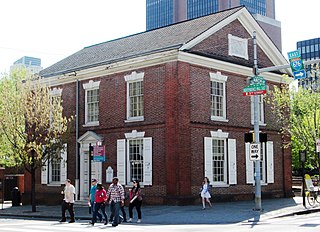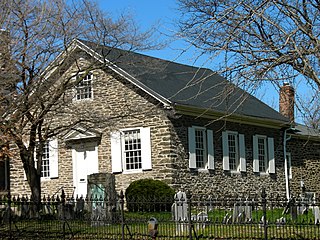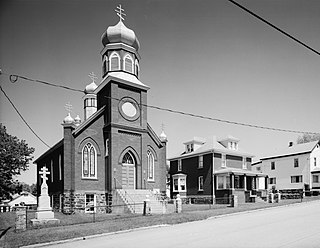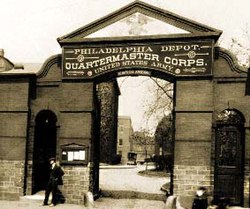
Fort Mifflin, originally called Fort Island Battery and also known as Mud Island Fort, was commissioned in 1771 and sits on Mud Island on the Delaware River below Philadelphia, Pennsylvania near Philadelphia International Airport.

West Overton is located approximately 40 miles (64 km) southeast of Pittsburgh, in East Huntingdon Township, Westmoreland County, Pennsylvania, United States. It is on PA 819 between the towns of Mount Pleasant and Scottdale. Its latitude is 40.117N and its longitude is -79.564W.

Philadelphia's Baltimore & Ohio Railroad station – also known as the B & O station or Chestnut Street station – was the main passenger station for the Baltimore & Ohio Railroad in Philadelphia, Pennsylvania. Designed by architect Frank Furness in 1886, it stood at 24th Street and the Chestnut Street Bridge from 1888 to 1963.

The Cliffs is a historic country house located near 33rd and Oxford Streets in East Fairmount Park, Philadelphia. It is a Registered Historic Place.

Grumblethorpe, in Germantown, Philadelphia, Pennsylvania, was the home of the Wister family, who lived there for over 160 years. It was built in 1744 as a summer residence, but it became the family's year-round residence in 1793. It is a museum, part of the Colonial Germantown Historic District.

Summerseat, also known as the George Clymer House and Thomas Barclay House, is a historic house museum at Hillcrest and Legion Avenues in Morrisville, Bucks County, Pennsylvania. Built about 1770, it is the only house known to have been owned by two signers of the United States Declaration of Independence, Founding Fathers George Clymer and Robert Morris, and as a headquarters of General George Washington during the American Revolutionary War. The house is now managed by the Morrisville Historical Society, which offers tours. It was designated a National Historic Landmark in 1965.

The Philadelphia Lazaretto was the first quarantine hospital in the United States, built in 1799, in Tinicum Township, Delaware County, Pennsylvania. The site was originally inhabited by the Lenni Lenape, and then the first Swedish settlers. Nearby Province Island was the site of the confinement of the Christian Moravian Indians who were brought there under protective custody from Lancaster, Pennsylvania, in 1763 when their lives were threatened by the Paxton Boys. The facility predates similar national landmarks such as Ellis Island Immigrant Hospital and Angel Island and is considered both the oldest surviving quarantine hospital and the last surviving example of its type in the U.S.

The Strawberry Mansion Bridge is a steel arch truss bridge across the Schuylkill River in Fairmount Park in Philadelphia, Pennsylvania.

Lemon Hill is a Federal-style mansion in Fairmount Park, Philadelphia, built from 1799 to 1800 by Philadelphia merchant Henry Pratt. The house is named after the citrus fruits that Pratt cultivated on the property in the early 19th century.

The Free Quaker Meetinghouse is a historic Free Quaker meeting house at the southeast corner of 5th and Arch Streets in the Independence National Historical Park in Philadelphia, Pennsylvania. It was built in 1783, and is a plain 2 1⁄2-story brick building with a gable roof. The second floor was added in 1788. The building was moved about 30 feet to its present site in 1961, to allow for the widening of Fifth Street.

Mennonite Meetinghouse is a historic Mennonite church building at 6119 Germantown Avenue in Philadelphia, Pennsylvania.

Central Trust Company Buildings are two historic commercial buildings located at Altoona, Blair County, Pennsylvania. They are two five-story buildings connected by a stair and elevator tower. The buildings measure 130 by 120 feet. The Central Trust Company Building was built in 1905 and is a white glazed brick building with brownstone trim in the Beaux Arts style. The entry features two Ionic order engaged granite columns. The adjoining Brett Building was built between 1922 and 1924.

Downtown Altoona Historic District is a national historic district located at Altoona, Blair County, Pennsylvania. The district includes 240 contributing buildings in the central business district and surrounding residential areas of Altoona. The buildings were primarily built after about 1860 and include residential, civic, social, and religious buildings. Although it does not encompass the entire downtown, it is for the most part the most urban part of Altoona's downtown district. Notable buildings include the Cathedral of the Blessed Sacrament (1920s), First Methodist Episcopal Church, First Presbyterian Church, First Evangelical Lutheran Church (1896-1897), U.S. Post Office (1931-1933), Fraternal Order of Eagles Building (demolished), Altoona City Hall, Casanave Building (1890s), Hutchison Block, McCrory's Department Store (1937), and Aaron-Penn Furniture Building. Located in the district are the separately listed Central Trust Company Buildings, Mishler Theatre, and Penn Alto Hotel.

Mount Union Historic District is a national historic district located at Mount Union in Huntingdon County, Pennsylvania. The district includes 58 contributing buildings, 3 contributing sites, and 1 contributing structure in the central business district and surrounding residential areas of Mount Union. Notable buildings include the Federal-style John Shaver House (1818), Shapiro Theater (1915), T.A. Appleby Store and House, Kenmar Hotel, Penn Central National Bank (1916), Peduzzi's and the Weller Building (1913-1914), Pennsylvania Railroad Freight Depot (1914), St. Luke's Evangelical Lutheran Church (1904-1905), First United Methodist Church (1925-1926), St. Catherine of Siena Roman Catholic Church (1912-1913), Mount Union Elementary School (1923-1924), and U.S. Post Office (1936). The contributing sites include the I.O.O.F. community cemetery, founded in 1872, and the former Victoria Park. Located in the district and listed separately is the Harbison-Walker Refractories Company complex.

Boswell Historic District is a national historic district located at Boswell in Somerset County, Pennsylvania. The district includes 90 contributing buildings and 1 contributing site. It encompasses an area developed by the Merchant's Mining Company of Baltimore, Maryland starting in 1901. It includes the remaining extant mine resources and the archaeological remains of the mine. They consist of utilitarian industrial buildings, four types of vernacular housing, and a variety of commercial, social, and institutional buildings. Notable buildings include the First National Bank of Boswell (1919), Merchant's Coal Company office (1901), St. Stanislaus Roman Catholic Church (1918), and Sts. Peter and Paul Russian Orthodox Church (1918).

Sterrett-Hassinger House, also known as David Sterrett House, was a historic home located at Upper Mifflin Township in Cumberland County, Pennsylvania. It was built about 1789–1791, and modified between about 1830-1835 and 1850. The house was demolished after a fire.

John Turn Farm is a historic farm complex located in the Delaware Water Gap National Recreation Area at Middle Smithfield Township, Monroe County, Pennsylvania, USA. The complex includes the lime kiln, smoke house and weave house. The property also includes the site of the demolished main farmhouse, a smaller house, a barn and garage.

Boelson Cottage is a Dutch and Swedish-style colonial era cottage located in Fairmount Park, Philadelphia. The 1+1⁄2-story gambrel-roofed fieldstone cottage was built sometime between 1678 and 1684. The cottage is situated on the west bank of the Schuylkill River within a plot of 100 acres (40 ha) of land granted to John Boelson in 1677 by the Swedish colonial court in Upland, Pennsylvania. Boelson's cottage is the oldest extant structure in Fairmount Park.

Ormiston Mansion is a 2+1⁄2-story, red brick, late Georgian period house located in east Fairmount Park, Philadelphia. The house was constructed in 1798 with a large wooden porch in front and a smaller porch in the rear. Many of the original interior features remain including fireplaces with marble mantles and a Scottish bake oven. The cedar shake roof includes a widow's walk and Federal-style dormers, while six large shuttered windows are on each side of the house, and five on the front. The first floor interior includes a large drawing room spanning the entire width of the house, a kitchen, and a dining room with a large door leading to the rear porch. The back of the house overlooks the Schuylkill River.

Rockland Mansion is a 2+1⁄2-story Federal-style mansion located in east Fairmount Park, Philadelphia, overlooking the Schuylkill River. The land was bought by a Philadelphia merchant named George Thomson in 1809. The mansion was completed circa 1810 using rubble stone for the masonry work which was then finished with stucco scored to resemble cut stone. Thomson used the house as a summer residence for about five years and then sold it to another merchant named Isaac Jones in 1815 whose son sold it to the city in 1870. The house and original plot of 26 acres (11 ha) of land are situated adjacent to the Mount Pleasant Mansion along Mount Pleasant Drive.























